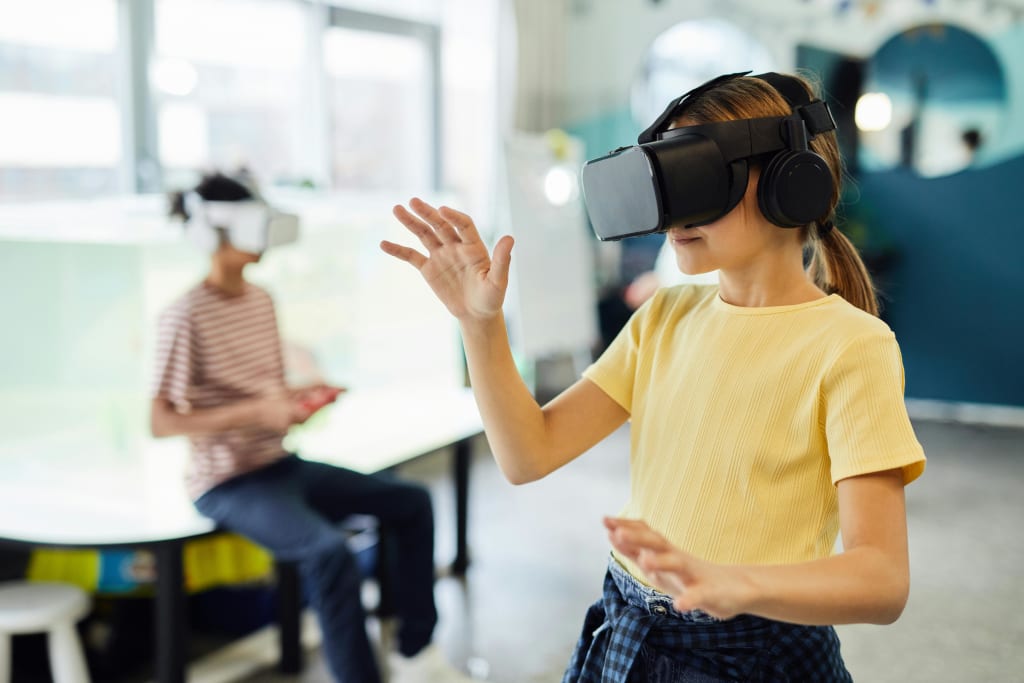Metaverse Workspaces: Remote Working in Virtual Reality.
Discover the future of remote work with Metaverse Workspaces, where virtual reality technology transforms the way we collaborate and communicate.

The Rise of Virtual Reality in Remote Work
Virtual reality (VR) has emerged as a game-changing technology in the realm of remote work. With the ability to create immersive and interactive experiences, VR is revolutionizing the way teams collaborate and communicate from different locations. The rise of VR in remote work has opened up a world of possibilities, allowing for more engaging and productive virtual meetings, training sessions, and brainstorming sessions.
One of the key advantages of using VR in remote work is the ability to create a sense of presence, where users feel as if they are physically present in a shared virtual space. This can help overcome the limitations of traditional video conferencing tools, which often lack the ability to capture non-verbal cues and create a truly immersive environment. By using VR, remote teams can foster a sense of connection and collaboration, regardless of geographical distances.
Moreover, VR enables remote workers to visualize and manipulate complex data in a more intuitive and interactive manner. This can be particularly beneficial for industries such as architecture, engineering, and design, where spatial understanding and visualization are crucial. By using VR, remote teams can collaborate on 3D models, prototypes, and simulations, leading to more efficient and effective decision-making processes.
As VR technology continues to advance and become more accessible, we can expect to see a further integration of VR tools into remote work environments. This will not only enhance the remote work experience but also enable teams to work together in ways that were previously unimaginable.
Benefits of Metaverse Workspaces for Remote Teams
Metaverse Workspaces offer a range of benefits for remote teams, making it an ideal solution for virtual collaboration and communication. One of the key advantages of Metaverse Workspaces is the ability to create a shared virtual environment where team members can interact and collaborate in real-time. This fosters a sense of presence and enhances the feeling of being physically together, despite being geographically apart.
In addition to the sense of presence, Metaverse Workspaces provide a highly immersive and interactive experience. Users can customize their avatars, explore virtual environments, and interact with objects and tools in a natural and intuitive way. This not only enhances engagement but also promotes creativity and innovation within remote teams.
Another benefit of Metaverse Workspaces is the ability to overcome the limitations of traditional video conferencing tools. With VR, remote teams can communicate and collaborate in a more natural and intuitive manner, using gestures, body language, and spatial audio. This creates a more dynamic and interactive virtual meeting experience, leading to more effective communication and collaboration.
Furthermore, Metaverse Workspaces offer flexibility and convenience for remote teams. Users can access the virtual workspace from anywhere, at any time, using VR headsets or other compatible devices. This eliminates the need for physical office spaces and allows for seamless remote collaboration, even across different time zones.
Overall, Metaverse Workspaces provide remote teams with a powerful and innovative platform for virtual collaboration and communication. By leveraging the benefits of VR technology, teams can overcome the challenges of remote work and unlock new levels of creativity, productivity, and engagement.
Challenges and Solutions in Virtual Reality Remote Working
While virtual reality (VR) remote working offers numerous benefits, it also comes with its own set of challenges. One of the main challenges is the cost and accessibility of VR equipment. VR headsets and other necessary hardware can be expensive, making it difficult for all team members to have access to the required equipment. However, as VR technology becomes more mainstream, we can expect the cost to decrease and accessibility to improve.
Another challenge is the potential for motion sickness and discomfort during VR experiences. Some individuals may experience nausea, dizziness, or eye strain when using VR headsets for extended periods. To address this challenge, it is important to take regular breaks, adjust the headset for optimal comfort, and ensure that the VR experience is designed with user comfort in mind.
Furthermore, VR remote working may present challenges in terms of data security and privacy. As remote teams collaborate and share sensitive information in virtual environments, it is crucial to implement robust security measures to protect data from unauthorized access or breaches. This includes using secure networks, encryption protocols, and access controls.
To overcome these challenges, it is important to provide comprehensive training and support for remote teams using VR for remote work. This includes training on how to use VR equipment, managing VR-related discomfort, and understanding data security best practices. By addressing these challenges and providing the necessary support, remote teams can fully leverage the benefits of VR remote working.
Tips for Maximizing Productivity in Virtual Reality Workspaces
Virtual reality (VR) workspaces offer a unique and immersive environment for remote teams to collaborate and communicate. To maximize productivity in VR workspaces, consider the following tips:
1. Set clear goals and objectives: Clearly define the purpose of the VR workspace and outline specific goals and objectives for each session. This will help keep the team focused and ensure that everyone is on the same page.
2. Plan and prepare in advance: Before entering the VR workspace, make sure to plan and prepare any necessary materials, documents, or tools. This will help minimize distractions and ensure a smooth and efficient workflow.
3. Establish communication norms: Establish clear communication norms and protocols within the VR workspace. This includes guidelines for speaking, listening, and taking turns during virtual meetings or discussions.
4. Utilize collaboration tools and features: Take advantage of the collaborative features and tools available in the VR workspace. This may include virtual whiteboards, 3D modeling tools, or shared document editing capabilities.
5. Encourage active participation: Foster a culture of active participation and engagement within the VR workspace. Encourage team members to share their ideas, ask questions, and contribute to the discussions.
6. Take regular breaks: VR experiences can be immersive and intense. Encourage team members to take regular breaks to rest their eyes, stretch, and recharge. This will help prevent fatigue and maintain productivity.
By following these tips, remote teams can make the most of VR workspaces and create a productive and engaging virtual work environment.
The Future of Remote Work: Virtual Reality Trends and Innovations
The future of remote work is set to be shaped by virtual reality (VR) technology, with exciting trends and innovations on the horizon. One of the key trends is the increasing integration of VR into existing remote work tools and platforms. We can expect to see VR features and functionalities being added to popular collaboration tools, project management platforms, and communication software.
Another trend is the development of more advanced and user-friendly VR hardware. Currently, VR headsets can be bulky and require external sensors or cables. However, advancements in VR technology are leading to the development of lighter, wireless, and more immersive headsets. This will make VR more accessible and comfortable for remote workers.
Furthermore, the future of VR remote work is likely to include the use of augmented reality (AR) and mixed reality (MR) technologies. These technologies combine virtual elements with the real world, allowing remote workers to overlay virtual objects or information onto their physical environment. This opens up new possibilities for remote collaboration, training, and remote assistance.
Additionally, the future of VR remote work will be shaped by advancements in artificial intelligence (AI) and machine learning. AI-powered VR assistants and virtual meeting facilitators can help streamline remote work processes, automate repetitive tasks, and provide personalized support to remote teams.
In conclusion, the future of remote work is closely intertwined with the advancements in virtual reality technology. As VR continues to evolve and become more integrated into remote work environments, we can expect to see a transformation in the way teams collaborate, communicate, and innovate.
About the Creator
Enjoyed the story? Support the Creator.
Subscribe for free to receive all their stories in your feed. You could also pledge your support or give them a one-off tip, letting them know you appreciate their work.






Comments
There are no comments for this story
Be the first to respond and start the conversation.